Believe it or not, marketing isn’t a popularity contest.
Sure – in theory you want as many people as possible to know and like your brand.
But like most businesses, you probably have a finite marketing budget, and would prefer not to blow the whole thing on an exorbitantly priced TV ad. Even if that ad got your brand in front of a lot of eyes, will those be the right eyes?
And do you really want to gamble your entire war chest on a single, high-cost brand awareness campaign that’s not guaranteed to grow your long-term customer base?
No. You want affordable marketing that works.
So what do you do? You practice growth marketing.
What is growth marketing?
Growth marketing is a calculated, data-driven attempt to cost-effectively target specific audiences with the intent of shepherding them to a sale and, eventually, customer loyalty. The growth marketer calibrates for the entire customer journey in order to grow their base of loyal customers.
Growth marketing isn’t just about rapidly growing your audience.
Contrary to what you may have read elsewhere, growth marketing isn’t just about rapidly growing your audience.
In fact, you might say that steadily growing the right audience is just one small part of growth marketing.
The rest of growth marketing is about building relationships with that audience.
And you do that with very purposeful marketing campaigns designed to move the target audience through the marketing and sales funnel.

What goes into growth marketing strategies?
Growth marketing is sort of like eating well and doing exercise to get buff. The payoff isn’t as immediate as injecting human growth hormone, but it’s a lot more sustainable.
The end goal of growth marketing is, well, long-term growth – both in terms of the volume of customers and, more importantly, in sustained revenue.
Every growth marketing strategy has a few core components:
1. Know your audience
There’s nothing about growth marketing that isn’t deliberate, and that includes who you choose to target.
That’s why step one is to pinpoint who you would most like to make aware of your brand. Create personas for your ideal audience, including your influencers and decision-makers.
This is an example of one of our audience personas:

This is an example of one of our influencer personas:
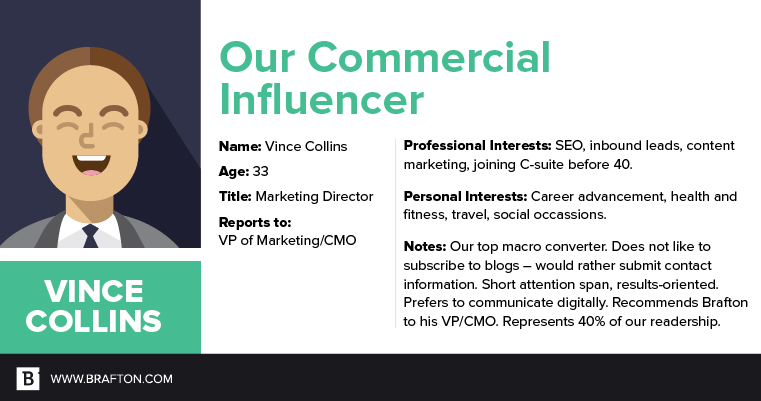
And this is our buyer:
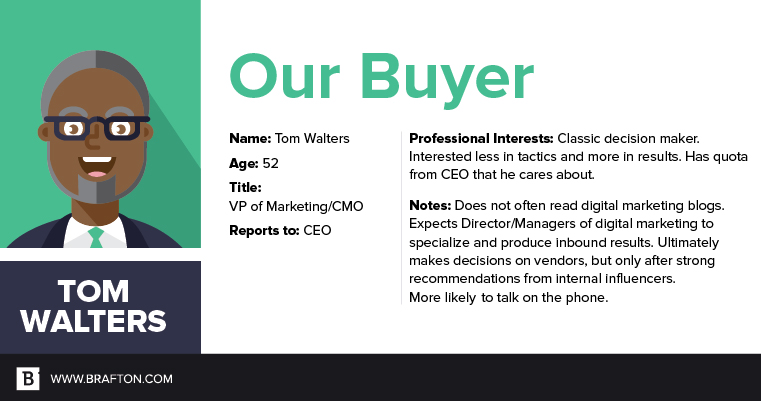
2. Choose your distribution channels
Once you have your initial personas, it’s time to figure out the most cost-effective way to reach them. This requires an understanding of what channels they use. Thirty-five years ago, channels were chiefly limited to TV, magazine and newspaper ads, billboards and other traditional marketing platforms.
Now we also have:
- Search: If your target audience is regularly performing Google searches to solve a problem, then they’re using this channel.
- Web: This can encompass everything from your company website to YouTube, Quora, Yelp and other web-based channels.
- Email: More than half of the world’s population uses it, and that likely includes your target audience. It’s no wonder email marketing is more profitable than most other forms of digital marketing.
- Social media: Facebook, LinkedIn, Twitter, Instagram, Reddit and others.
- Mobile: Mobile applications, beacon technology and text messaging can also be used as marketing channels.
Don’t think of these channels just as platforms for advertising, but as launchpads for value-added, organic content campaigns.
Google has Google Ads. Twitter has promoted posts. Facebook has Facebook Ads. Then there’s display ad networks that post your ads on various websites.
But the average click-through rate (CTR) for paid content is notoriously low. Only about a quarter of web users now have ad blockers. Disregarding the fact that 25% of your audience may not see your ad, the CTR for display ads isn’t even a tenth of a percent.
Paid ads have their place, such as retargeting and even as a promotion tactic for your content.
But marketers be warned: Investing in digital ads only works when part of a bigger growth strategy. Use distribution channels for their intended purpose – to deliver organic content to your target audience that’s of real value.
You’ll get a lot more long-term exposure and brand engagement with native content that people actually care about than with a bombardment of ads – and that more or less sums up inbound marketing.
3. Set measurable short-term goals and execute on them
What short-term goals do you need to accomplish on your selected channels in order to build up to your long-term goal?
Let’s use the examples of web and search. Every brand needs a good website that’s discoverable through search – so we’ll make that our goal.
You can achieve this with a combination of search engine optimization and content marketing.
On the SEO side, you need to make sure your site is crawlable. This requires a technical assessment of your site health using hard metrics such as:
- Page speed.
- Broken internal links (404 errors).
- Duplicate tags.
- Redirect issues (302 instead of 301).
- Total number of site errors.
Tools like Screaming Frog can help identify technical SEO issues that affect your ranking. Fix those issues, and you can actually measure within weeks how those changes have affected search performance using tools like SEMrush and Google Search Console.

Once you have a technically sound foundation, you can use content marketing to attempt to rank for more keywords. Tools like SEMrush can help you create lists of keywords that map back to your area of expertise.
Step 1
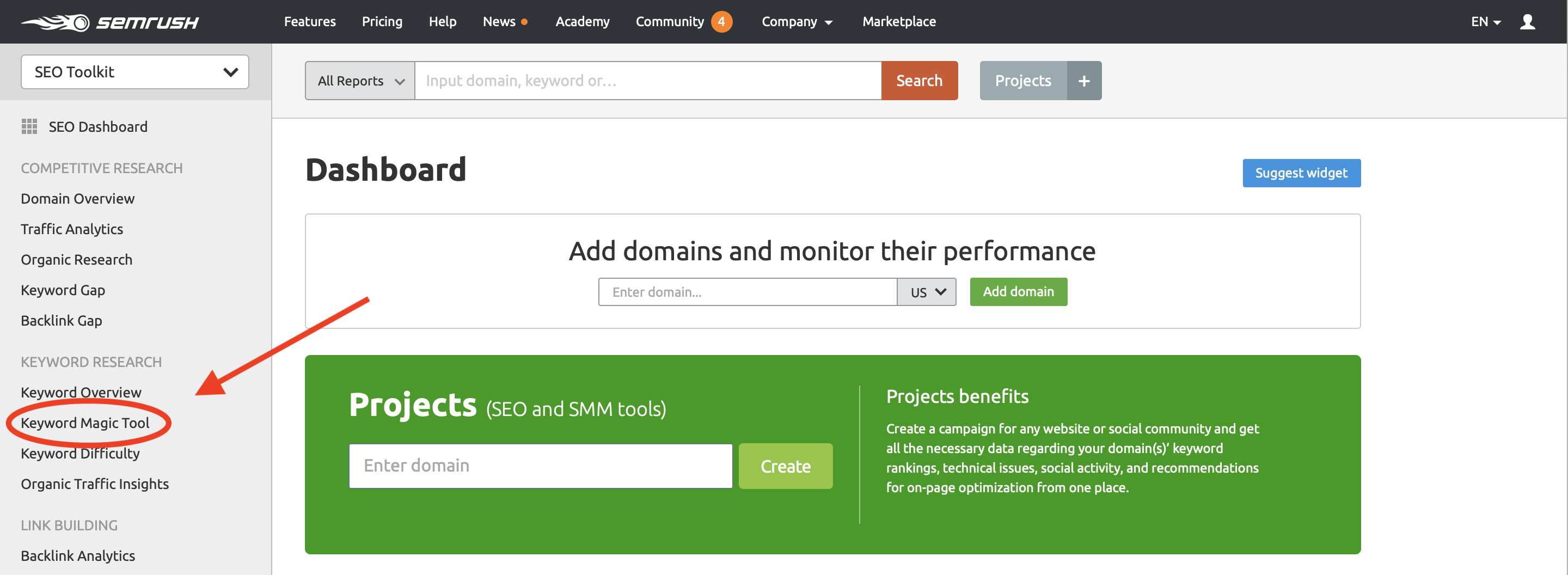
Step 2
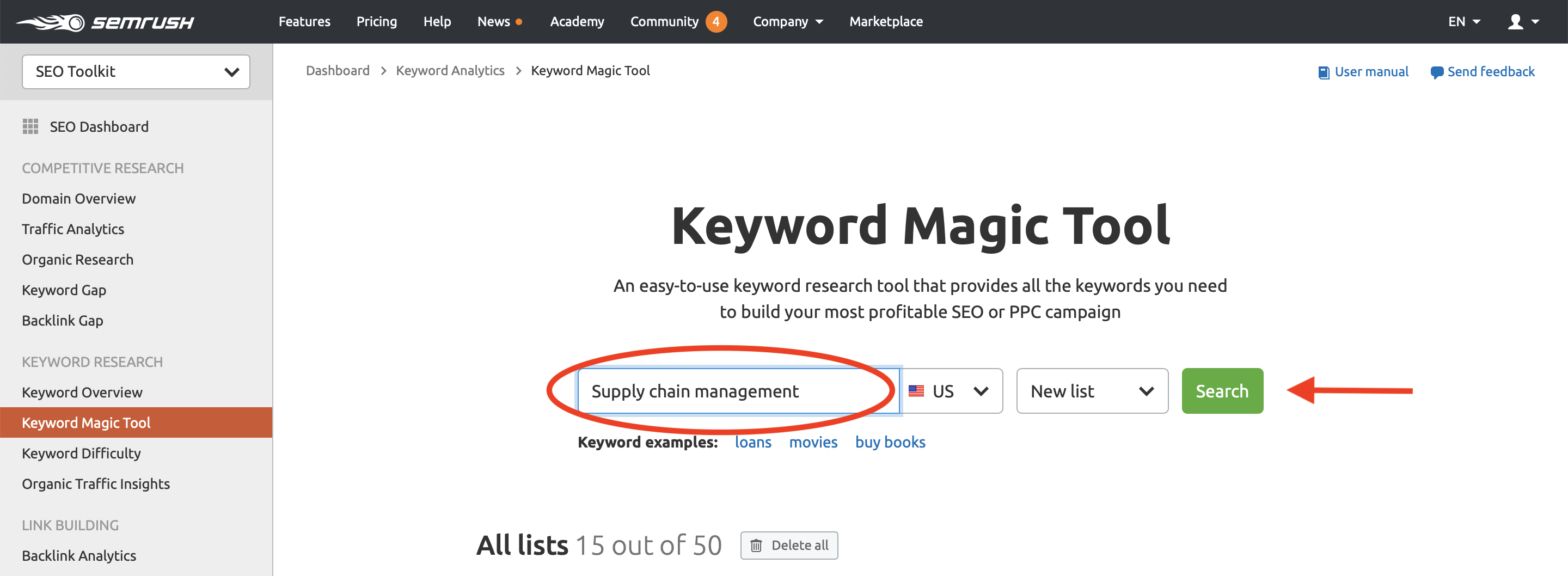
Step 3
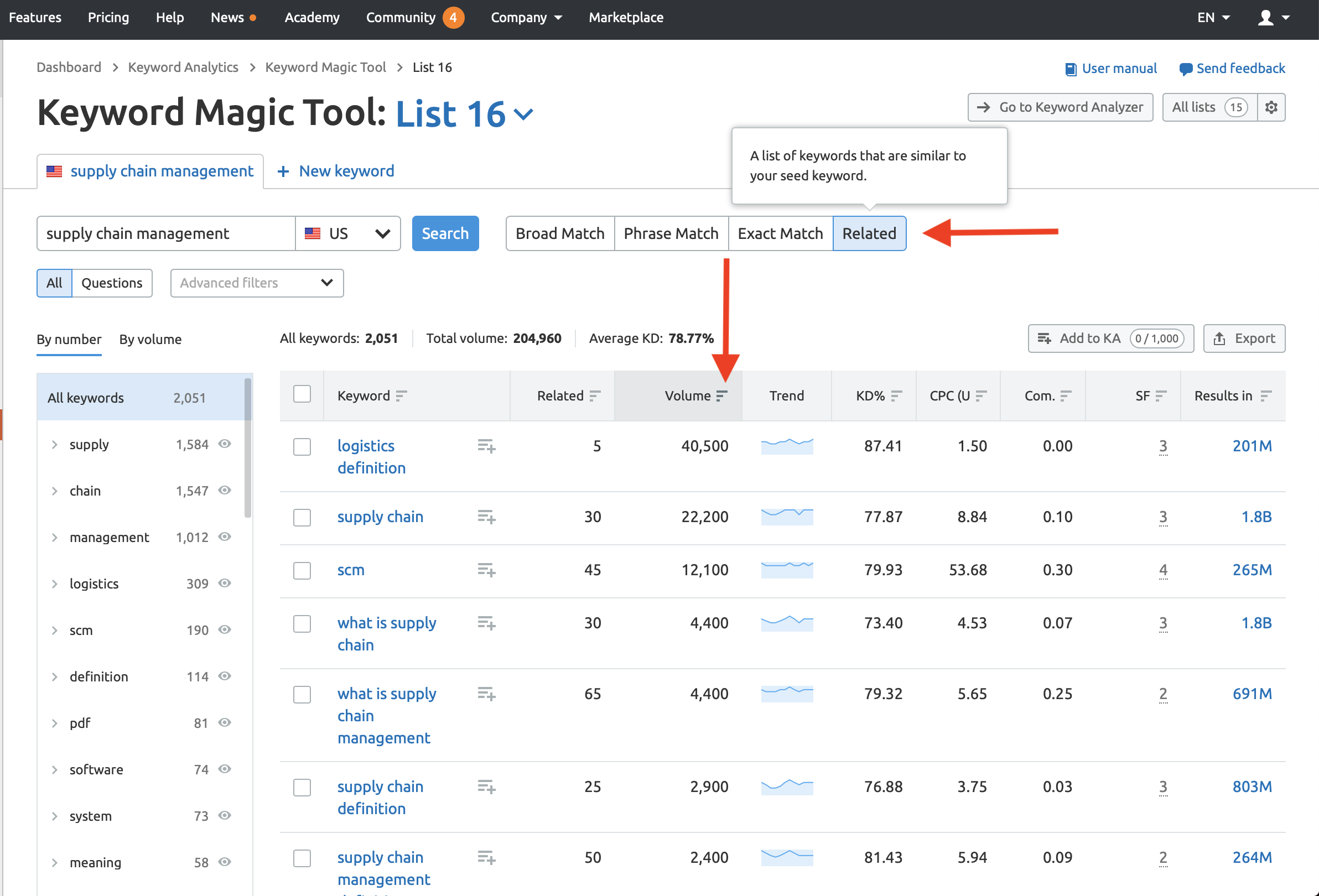
Do a bit more digging into the keywords. Find out who’s ranking in the top spots for them. Consider using a tool like MarketMuse to figure out exactly what topics you would need to cover in a piece of content in order for it to rank.
Sounds like a lot of steps? Once you get the hang of it, you can find a keyword, analyze it and figure out what content you need to create to rank for it in, give or take, under 30 minutes.
Creating the actual content might take a little longer.
But you can do this entire exercise 50 times and create 50 pieces of content and it would still cost you substantially less than what you pay for a single TV ad to air once on national TV.
And guess what? The content you post stays on the web for good.
This method is what you might call a growth hack – which is another name for a tactic within a growth marketing strategy that cost-effectively achieves a desired business outcome.
Such efforts are affordable, and more importantly, they’re sustained. The results just keep on coming.
4. Follow through
Never lose sight of the bigger goal. In growth marketing, that’s typically increasing customer acquisition and boosting sustained revenue.
For example, let’s say your SEO efforts are starting to pay off, and you’re getting traffic on your site.
Great! Now what are you doing to turn that traffic into leads? One simple method is to create opt-in forms like this one:

At Brafton, our way of capturing emails is with a newsletter that provides marketing tips, strategies, templates, campaign examples and so on.
Your way might be different. For instance, SaaS companies might provide access to a free tool in exchange for an email address.
The point is, you’re automating lead building. You’re maximizing the value of your web domain to generate leads.
And once you have those leads, you can begin using other methods such as email marketing to help turn them into prospects and, ultimately, customers.
5. Prioritize loyalty
Cross-selling and upselling to existing customers is always cheaper than trying to acquire new customers. It may be a bit of a cliche, but the customer you already have is the best customer to sell to.
The customer you already have is the best customer to sell to.
Don’t neglect the part of your marketing funnel that caters to existing clients:
- Develop engaging customer loyalty programs with tangible rewards.
- Continue to provide resources to existing customers to help them get more value out of your products.
- Launch user-generated content campaigns on social media to give your existing customers a chance to be heard (this also helps you bring attention to your brand and provides social proof of your value).
- Invest in customer service – because there’s no better or more valuable form of marketing than providing a strong experience that will make customers want to stick around.
Who needs growth marketing, and who doesn’t?
Growth marketing is ideal for:
1. Companies that want more sustained revenue
Growth marketing is, at the end of the day, all about increasing long-term revenue. This requires a methodical approach to staying relevant on the right distribution channels.
For example, it means building out your portfolio of evergreen web content – blogs, white papers, eBooks, videos, landing pages, case studies and infographics. It means promoting that content through low-cost email marketing campaigns. It means knowing how frequently to post on social media.
By maintaining your presence on digital channels with the right content, your marketing team can sustain inbound revenue opportunities for years to come. And the best part? The ongoing operating expenses are far more manageable than they would be pricey ad campaigns.
2. Companies that want to scale their marketing operations
As your business’s growth rate increases, your marketing expenses risk becoming more bloated. Maybe you’ve opened new branches and now need to promote them. Or maybe you’re expanding your product offerings with some of the additional income you have, which means you need to create entirely new marketing campaigns.
The beauty of growth marketing strategies is that they’re highly scalable, meaning you can easily ramp up output without spending substantially more money.
Adding new webpages to your domain for each of your new physical branches, for example, isn’t terribly complicated or expensive (and it gives your business a huge advantage in local SEO). The same can be said for adding a new webpage for a new product or service.
Long story short, digital marketing is scalable marketing.
3. Startups
Definitely the most interesting on this list.
Nascent companies face more uncertainty when creating a growth strategy, particularly with product-market fit (basically, is your product fit for the customers in a particular market?).
Startups may not yet know precisely who their ideal buyers are, which makes it tougher to know exactly how to market in the most cost-effective manner.
A brand-new startup is probably still feeling out its identity, the identity of its potential customer base and the marketing tactics that will work to bring the two together.
This doesn’t mean that startups should squander venture capital on grand marketing gestures. In fact, the term growth hacking (and to some extent, growth marketing) has its origin in startup culture. Investors want to see growth fast. That puts pressure on the startup to launch the lowest-cost marketing campaigns with the highest possible yield.
One of the most brilliant examples of an organic growth hack came from Airbnb. In its early days – back when no one knew who they were – Airbnb built brand recognition by turning to a familiar, widely used online channel: Craigslist.
In a nutshell, the company created a tool that lets its hosts automatically post their Airbnb listing on Craigslist:

The idea is that it can tap into Craigslist’s already humongous audience. It’s a low-risk, relatively low-cost example of using a content channel organically.
Needless to say, the growth hacking strategy worked wonders.
Who doesn’t need growth marketing?
Any business that’s currently focused on a significant overhaul or rebranding may want to backburner growth marketing as it takes time to better understand its identity.
In fact, a mid-identity crisis business may want to table most marketing strategies during this period of discovery. It’s hard to grow your long-term revenue and build up a base of customers without a strong sense of brand identity.
The only other feasible scenario is if you’re broke, in which case, you have bigger problems than marketing.
But for the most part …
It’s really difficult to think of a situation where cost-effective, data-driven marketing that helps build up a base of loyal customers and drive recurring revenue wouldn’t make sense.
So unless you can think of a good reason not to, our stance on the issue is pretty straightforward: Go out and practice growth marketing.





